Content Moderation Tools (CMMOD) - Use Case - How to Improve the Process of Moderating Posts and Pages On Your Site
Use Case - How to Improve the Process of Moderating Posts and Pages On Your Site
Note: this guide requires:
- Content Moderation Tools - This document uses version 1.2.4
Video Use-Case
Introduction
Content Moderation Tools is a time-saving plugin for content editors and moderators. It helps editors moderating articles and improves communication between the post authors and editors.
Use Case Front-End
The moderator view: adding notes and comments to the reviewed post.

The post author view: marking the notes as completed and adding comments.
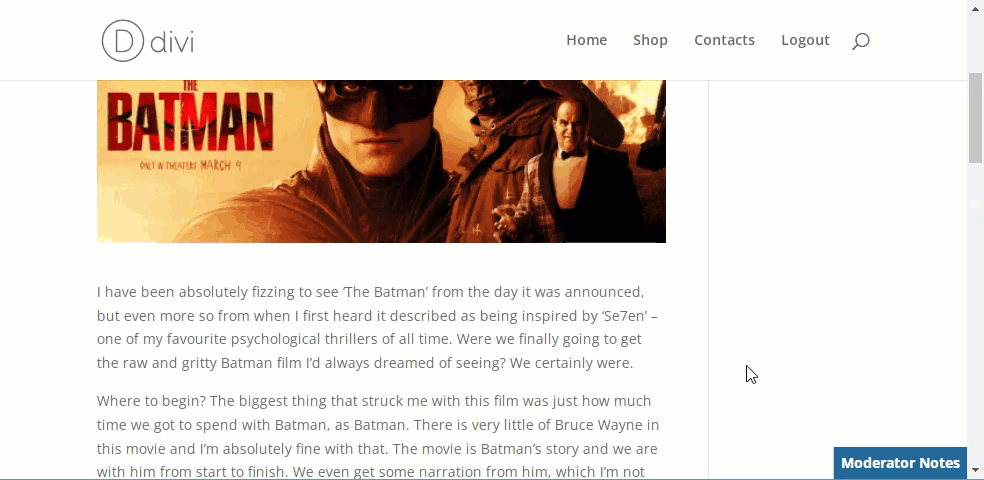
Example of one of the automated email notifications between moderator and post author:

Use Case Assumptions
In this example use case guide, we'll cover how to improve the process of moderating posts and pages on your site and increase the efficiency of communication between content moderators and post authors.
We assume that you have already bought the plugin, but not installed it yet.
It follows:
- Installing the plugin
- Dashboard overview
- Plugin settings
- The moderation / editing process
- End result
Installing The Plugin
The process is the same for all CM plugins and add-ons.

- Download the plugin from your customer dashboard.
- Log in to WordPress and navigate to the WordPress Admin → Plugins settings.
- Click on Add New.
- Activate it and add the license.
Learn more: Getting Started - Plugin Overview
Dashboard Overview
Let's start our acquaintance with an overview of the moderator's dashboard.
Content Moderation Tools adds a new item Pending posts to the admin dashboard for content moderators. This moderator's dashboard is helpful for managing the review process, especially when multiple authors are writing or when many posts are being submitted.
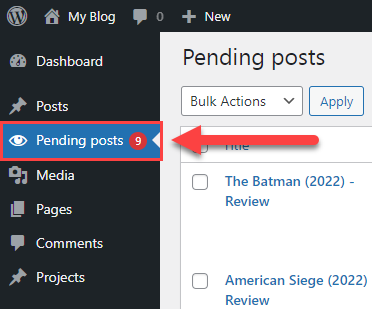
This dashboard displays the list of posts by all contributors that are waiting for a review. This includes all new articles that have been added or any article that was sent back to the contributor with moderator notes and has subsequently been revised and returned for review once again.
The options and columns are:
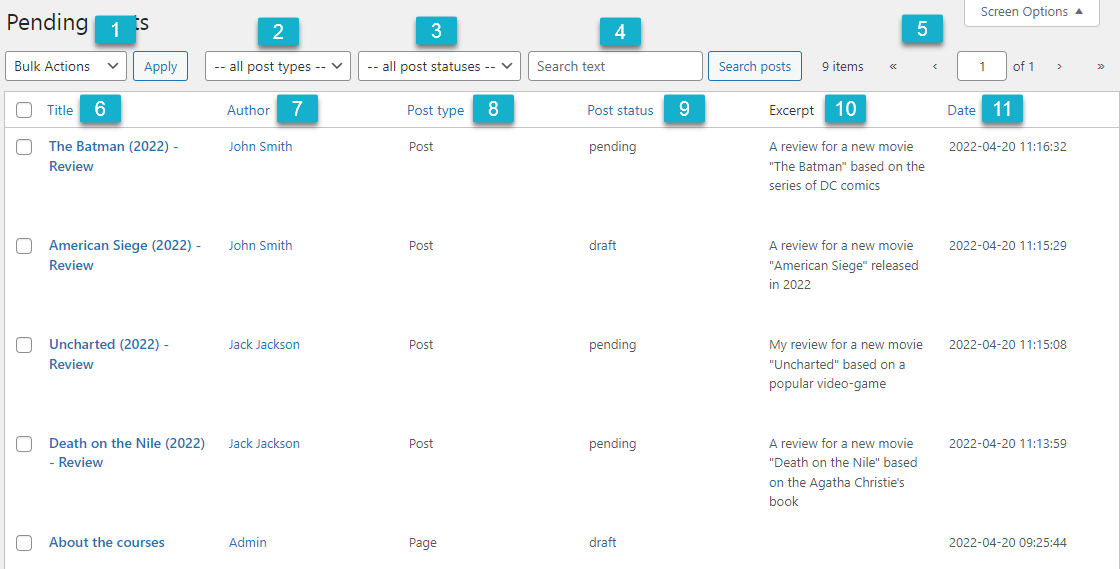
- Bulk Actions - Here the moderator can apply bulk actions to marked posts: Publish, Move to Trash or Delete.
- Filter by post type - Choose the post type you want to filter and click the button Search posts. Types of posts are defined in plugin settings.
- Filter by post status - Choose the post status you want to filter and click the button Search posts. Statuses of posts are defined in plugin settings.
- Filter by text - Enter the text that you want to find in pending posts and click the button Search posts.
Navigation bar - The table shows 20 items maximum per each page, so the moderator can use these buttons for navigation between the pages.
The table has the following columns:
- Title
- Author
- Post type
- Post status
- Excerpt
- Date
The moderator can order the results by all columns except Excerpt.
Hovering on each post allows to apply the following actions:

- Edit
- Trash
- Delete
- View
- Publish
Now let's head to the plugin settings.
Plugin Settings
To define the content moderators and which post types should be allowed for reviewing, navigate to Admin Dashboard → CM Editor Moderation Tools → Settings.
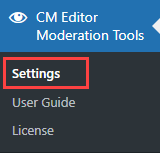
There are three tabs with settings:

- General
- Notifications
- Labels
General Settings
First tab is General.

It consists of a few sections.
Dashboard
In this section you define which post types will be displayed on the moderator's dashboard. The options are:
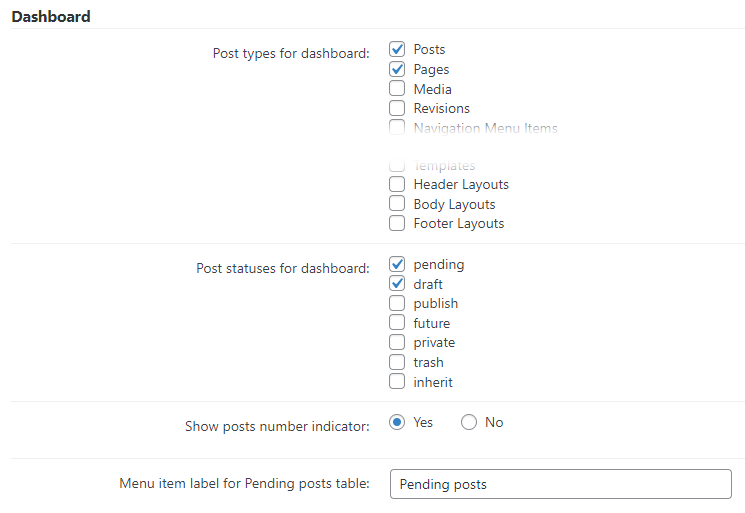
- Post types for dashboard - Choose post types which will be displayed on the moderator's dashboard.
- Post statuses for dashboard - Choose post statuses which will be displayed on the moderator's dashboard.
Show posts number indicator - Enable this option if you want to display the amount of pending posts on the moderator's dashboard.

Pending posts indicator Menu item label for Pending posts table - Change the name of the menu item for moderator's dashboard.

Pending posts label
Moderator notes
In this section you define which post types the moderators are allowed to review and leave notes. The options are:

- Post types for notes - Choose post types which the moderator's are allowed to review and leave notes.
- Post statuses for notes - Choose post statuses which the moderator's are allowed to review and leave notes.
Moderators
In this section you define which users will be moderators. These are chosen from the existing users on your site. Users without the permission to review pending posts on your site back-end can still be set as moderators - they will be able only to receive email notifications, but not able to review posts and leave notes. So, keep in mind that the users you want to be moderators should have corresponding user capabilities - for example edit_other_posts, edit_other_pages, etc.

To add a moderator, start entering the name of a needed user and click on him when his name appears. You can add any amount of moderators.

Then click the button Save at the bottom of the page.

Notifications
Second tab is Notifications.

After a content contributor submits a post for review in the usual way, the plugin begins a process of email notifications between the moderator and the author of the post.
These emails are sent to notify either the moderator or author about changes that happened in the review process. There are 4 email notification types.
Pending review
This email is sent to the moderator when a new post is submitted for review by one of the contributors on the website.
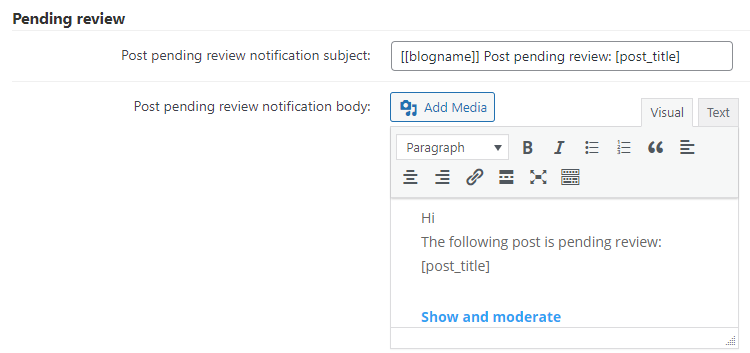
You can edit the subject and body of the email. The fields accept HTML and the following placeholders:
- [post_title]
- [post_author]
- [showurl]
- [permalink]
- [blogname]
- [siteurl]
Moderator sending notes
The second email is sent to the author of the post when the moderator completes a review and leaves notes. When the moderator finishes the review, the notes that he added will be sent via email to the author.
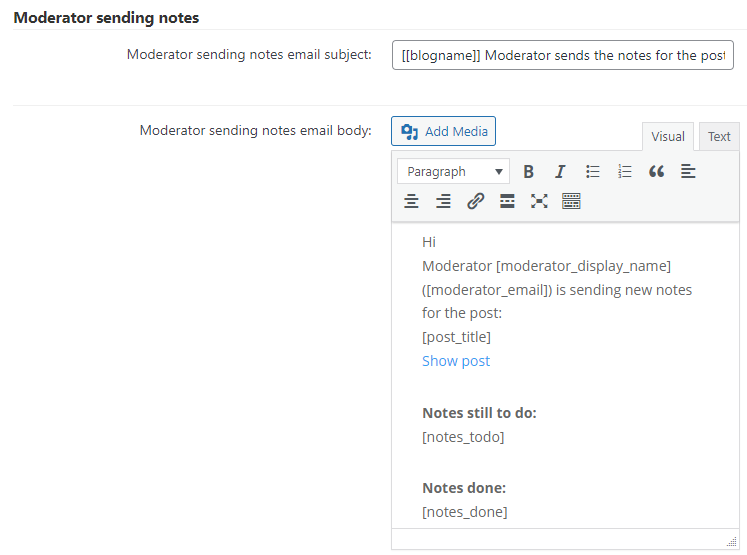
You can edit the subject and body of the email. The fields accept HTML and the following placeholders:
- [post_title]
- [post_author]
- [showurl]
- [permalink]
- [blogname]
- [siteurl]
- [notes_todo]
- [notes_done]
- [moderator_display_name]
- [moderator_email]
- [author_display_name]
- [author_email]
Author asked review
This message is sent to the moderator when the author reviewed the notes that were made on the post and made the suggested changes. When the author marks the notes as completed and clicks the "Ask for review" button, the moderator will receive a summary of the changes that have been made.
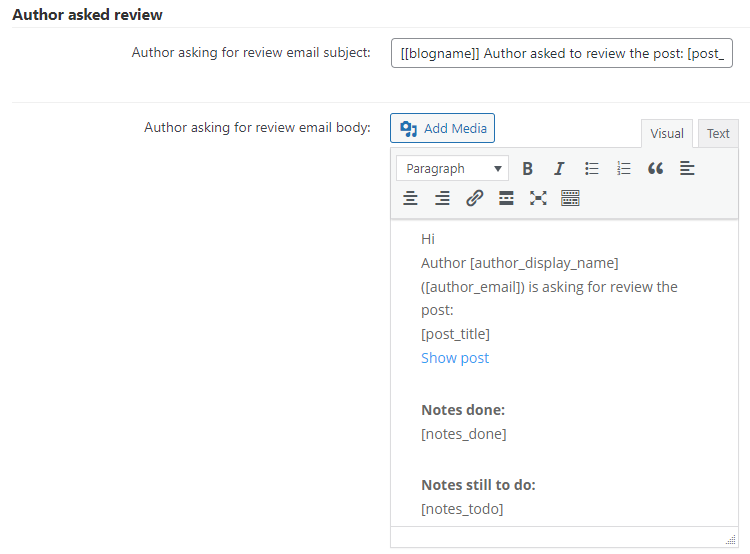
You can edit the subject and body of the email. The fields accept HTML and the following placeholders:
- [post_title]
- [post_author]
- [showurl]
- [permalink]
- [blogname]
- [siteurl]
- [notes_todo]
- [notes_done]
- [author_display_name]
- [author_email]
Moderator approve
This message is sent to the author when the moderator approved his post/page.
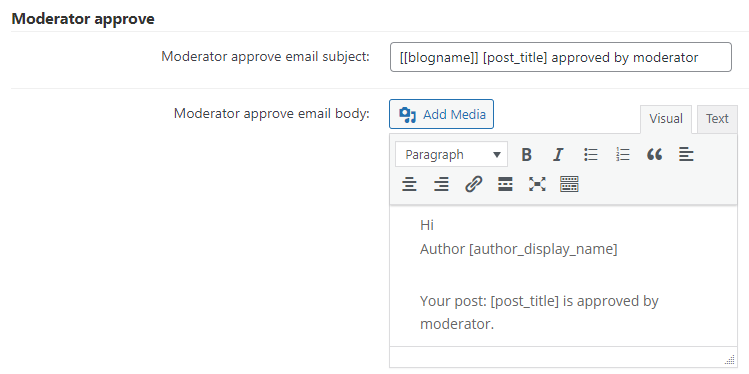
You can edit the subject and body of the email. The fields accept HTML and the following placeholders:
- [post_title]
- [post_author]
- [showurl]
- [permalink]
- [blogname]
- [siteurl]
- [notes_todo]
- [notes_done]
- [author_display_name]
- [author_email]
Labels
Last tab is Labels.

Under this tab you can edit or translate all front-end labels that are generated by the plugin.
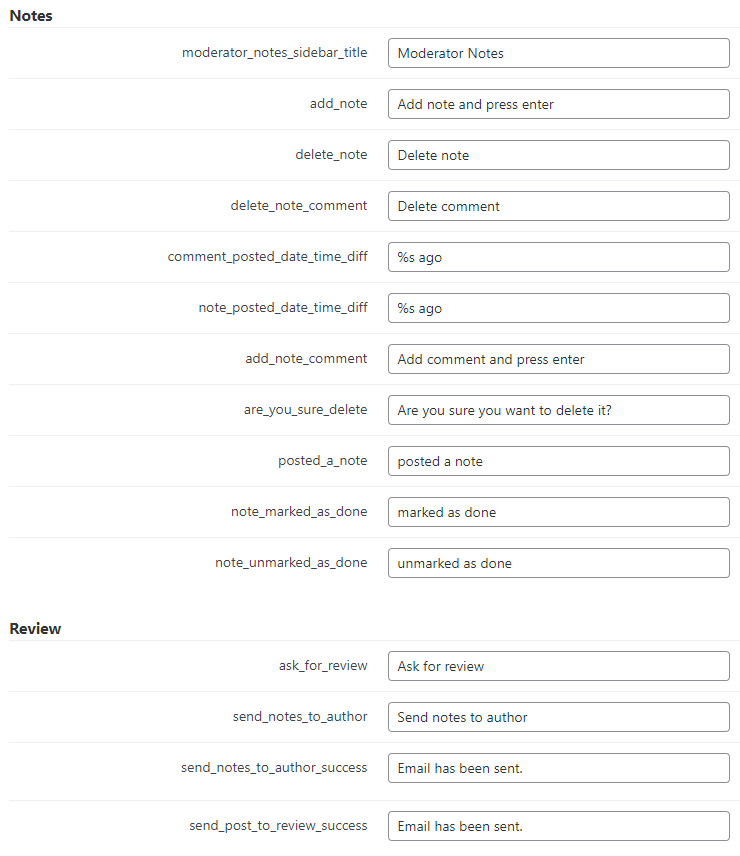
Don't forget to click the button Save after changing the settings.

The Moderation / Editing Process
Now let's see, how it all works in practice.
The author creates a post and saves it as a draft, or with a pending status, or any other status, when the post is not published and is ready for review.

The moderator receives an email notification that the post is waiting for a review.
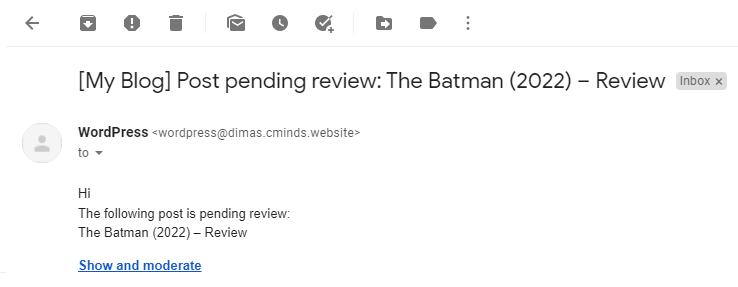
The moderator can either click on the link in the email to open and review the post or find it on the moderator's dashboard and click View.
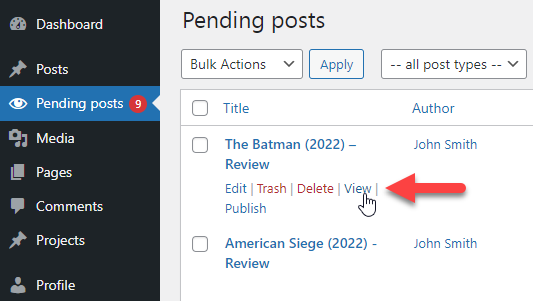
The reviewing happens on the front-end. The moderator opens the panel Moderator Notes. He can add or delete some notes and comments. After that he clicks the button Send notes to author.

The author of the post will receive the email that moderator has added the notes to the post. The email can contain the list of completed and not completed notes.

The post author can see on his post almost the same panel with Moderator notes. The author can mark the notes that were done and add some comments. When he finishes, he clicks the button Ask for review.

After that, the moderator will receive an email that Author asks to review his post. The email can contain the list of completed and not completed notes.
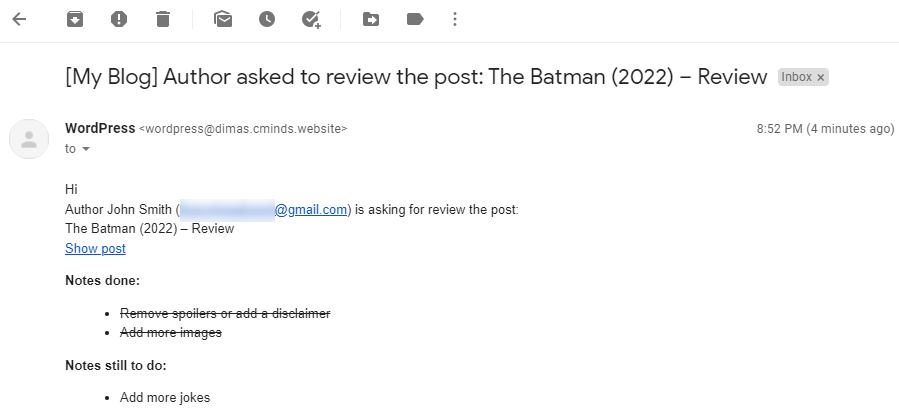
The process can repeat while the moderator adds notes and the author works on modifications - until the article becomes perfect. The moderator can publish the post on his moderator's dashboard by hovering on the post and clicking Publish.
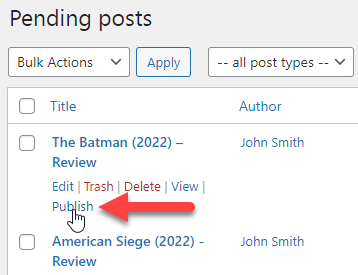
When the post is published, the post author will receive an email notification that his post is approved.
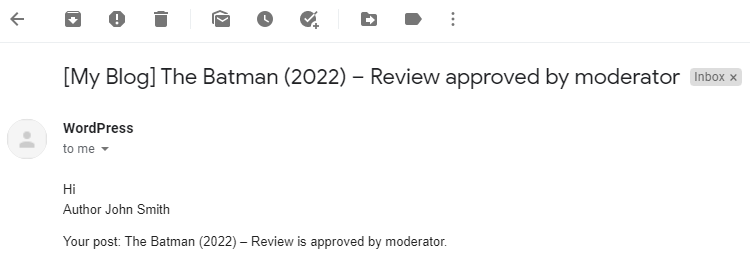
End Result
Following instructions found in the plugin and guides, you should be able to improve the process of moderating posts and pages on your site and increase the efficiency of communication between content moderators and post authors.
Use Case Front-End
The moderator view: adding notes and comments to the reviewed post.

The post author view: marking the notes as completed and adding comments.

Example of one of the automated email notifications between moderator and post author:

 |
More information about the Content Moderation Tools plugin for WordPress Other WordPress products can be found at CreativeMinds WordPress Store |
 |
Let us know how we can Improve this Product Documentation Page To open a Support Ticket visit our support center |


